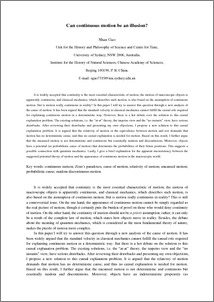Gao, Shan
(2013)
Can continuous motion be an illusion?
[Preprint]
![[img]](https://philsci-archive.pitt.edu/style/images/fileicons/application_pdf.png)  Preview |
|
PDF
Shan_Gao_-_Can_continuous_motion_be_an_illusion_2013.pdf
Download (143kB)
|
Abstract
It is widely accepted that continuity is the most essential characteristic of motion; the motion of macroscopic objects is apparently continuous, and classical mechanics, which describes such motion, is also based on the assumption of continuous motion. But is motion really continuous in reality? In this paper, I will try to answer this question through a new analysis of the cause of motion. It has been argued that the standard velocity in classical mechanics cannot fulfill the causal role required for explaining continuous motion in a deterministic way. However, there is a hot debate over the solution to this causal explanation problem. The existing solutions, i.e. the "at-at" theory, the impetus view and the "no instants" view, have serious drawbacks. After reviewing their drawbacks and presenting my own objections, I propose a new solution to this causal explanation problem. It is argued that the relativity of motion or the equivalence between motion and rest demands that motion has no deterministic cause, and thus no causal explanation is needed for motion. Based on this result, I further argue that the uncaused motion is not deterministic and continuous but essentially random and discontinuous. Moreover, objects have a potential (as a probabilistic cause of motion) that determines the probabilities of their future positions. This suggests a possible connection with quantum mechanics. Lastly, I give a brief explanation for the apparent inconsistency between the suggested potential theory of motion and the appearance of continuous motion in the macroscopic world.
Monthly Views for the past 3 years
Monthly Downloads for the past 3 years
Plum Analytics
Actions (login required)
 |
View Item |



